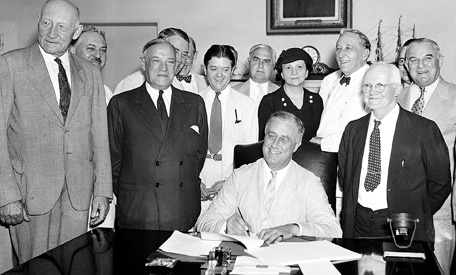Follow Erik Loomis on Twitter
Read Erik Loomis at Lawyers, Guns, & Money
Historian Erik Loomis on This Day in Labor History: August 14, 1935. President Franklin Delano Roosevelt signed the Social Security Act, bringing the modern welfare state to the American people and providing the nation’s poor long-desired old age insurance. Let’s talk about this program we still need.
The nation’s elderly had long lived with the potential of late-life poverty. The nation’s lack of a welfare state doomed the poor to rely on their families for survival, an impossibility for many. During the nation’s frequent economic downturns, this problem was worse.
The continued decline in quality of life for the elderly during the Great Depression helped spur a more organized movement for old-age insurance. Many advocates fell in behind Francis Townsend.
A California doctor, Townsend believed that if you put more money in the hands of the elderly, they would reinvigorate the economy with their spending.
The Townsend plan proposed a sizable pension of $200 a month to any American over the age of 60 and was based upon the federal investment in pensions for Civil War soldiers, the first welfare program in American history.
Townsend favored a sales tax rather than an income tax (proposed by Huey Long in his own old-age pension program) to pay for it.
People would have to spend every cent of the $200 each month and quit working in order to receive it, which Townsend said would open jobs for the young and spur the economy through spending.
By 1935, 28 states had passed old-age pensions of their own, although many of these provided no more than a dollar day, required a state residency of ten years, and limited eligibility to those over the age of 70.
Within Roosevelt’s Cabinet, no one advocated more for old-age insurance than Secretary of Labor Frances Perkins.
Organized labor had opposed Perkins’ appointment as Secretary of Labor for three reasons: she was the first Secretary of Labor that did not come from the labor movement, she was a woman, and she was a reformer rather than a unionist.
The American Federation of Labor (AFL) did not trust the federal government to run any kind of social welfare program.
Believing both that the government was always the tool of capital and that welfare would undermine the independence of the American worker, the AFL under William Green would oppose much of the New Deal, even if its rank and file loved FDR.
Perkins had long advocated for old-age insurance. Roosevelt initially opposed any long-term program, seeking instead a quick fix for the elderly through emergency relief. But by 1934, he had come around to Perkins’ view on the necessity of a permanent program.
FDR named Perkins the head of the Committee on Economic Security, combining politicians and academics, to create what would become Social Security.
At the same time the CES met, Townsend’s plan became famous. 25 million Americans signed petitions in support of the plan and 1200 clubs formed, mostly by the elderly, to promote it. Policymakers were not amused.
Perkins called it “a very large gift….much larger than the income which they enjoyed during their younger and working years” while others said the high sales taxes to fund it would hurt businesses. In addition, policymakers feared a federal plan.
Even FDR told Perkins that he preferred the states having a great deal of control because “Just think what it would be like to have the power in the federal government if Huey Long should become President.”
The final plan did preserve state old-age welfare programs but put the majority of power within the federal government.
Roosevelt insisted that the program be entirely self-supporting, not wanting a huge initial outlay to create massive debts for future generations. This meant much higher payroll tax rates, up to 6% of taxable payroll by 1949.
Today, we think of Social Security as something that is almost untouchable; despite Republican attempts to privatize the program, people really like it the way it is. That doesn’t mean it wasn’t controversial in 1935.
Roosevelt was so popular among the people that Democrats steamrolled the Republicans in the 1934 midterm elections. The giant congressional majorities that followed is how the bill passed. Much of Congress disliked the bill, particularly the increased federal presence.
Most of it offered little short-term political value. Only FDR’s overwhelming popularity prevented more open opposition.
Still, on March 20, 1935, the Times ran a story titled, “Hopes Are Fading for the Social Security Bill” that predicted the only piece of the bill that would get through would be some assistance for the indigent over 65 years old.
No one really knew what would happen to the bill once it reached the House floor. Some thought the Townsendites would overwhelm it and make it politically infeasible. Others believed right-wingers would demand lower tax rates and thus not fund it.
FDR used every trick in his book to push the bill through, making voting for it a matter of personal political loyalty to the most popular president in 20th century America at the peak of his powers. And the bill did pass overwhelming, by a 372-33 margin.
Still, that took a lot of compromising from Roosevelt, who accepted a scaled back bill that only covered about 60% of workers, excluding federal employees, professionals like doctors and attorneys, domestic workers, agricultural workers, and the self-employed.
The CES had strongly fought for including domestics and farm workers and giving these up was the last compromise FDR made.
Even then, the Senate nearly made the bill voluntary instead of compulsory after passing an amendment by Champ Clark that would have allowed for plans with more liberal provisions to opt out. The Clark Amendment got dumped in reconciliation.
Social Security proved immediately popular, even if AFL leaders grumbled.
Despite the fact that union members loved Social Security, it was only the emergence of the CIO and the success the rival federation had in wrapping itself in progressive New Deal policy that moved AFL leaders to accept that Social Security might not destroy voluntarism.
By 1938, the AFL joined the CIO in promoting expanded benefits. Republicans tried to make repealing it an issue in the 1936 elections. That didn’t work out so well for them.
The plan was not implemented until the Supreme Court decided its constitutionality in Helvering v. Davis in 1937.
Now, in context of today. When we talk about how bad “incremental programs” are, we forget that every single welfare program in American history is incremental. It took years for anyone to get SS benefits and so many were excluded. This is what it took to get passed.
When faced with the choice between incremental change and no change, you have to go with the former. For instance, Dems rejected Nixon’s limited health care program thinking they’d get more later. Nope. Took decades to get back to even that basic point with the Affordable Care Act.
With the Senate and courts so consistently reactionary (and the House then too given Jim Crow), we’ve had to take what change we can get when we win it. And that’s probably the case in the future too. Just have to keep fighting.
And of course that fight has to continue against Donald Trump and his attempt to suspend the payroll taxes that fund the program. Republicans would love for Social Security to die. This is very much not a fight that is over today. It’s continuing. And we have to demand it.

